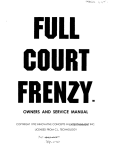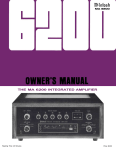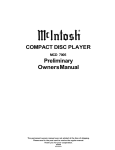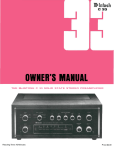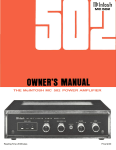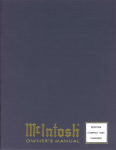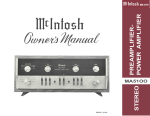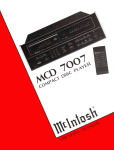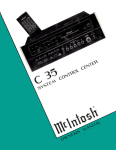Download THE MclNTOSH C32 SOLID STATE STEREO PREAMPLIFIER
Transcript
THE MclNTOSH C32 SOLID STATE STEREO PREAMPLIFIER Reading Time: 44 Minutes Price $1.25 WARNING: TO PREVENT FIRE OR SHOCK HAZARD, DO NOT EXPOSE THIS UNIT TO RAIN OR MOISTURE. The Mclntosh you have purchased has a serial number located on the rear panel of the chassis. Record that serial number here for future references. The model and serial number are important to you for any future service. Your C 32 Stereo Preamplifier will give you many years of pleasant and satisfactory performance. If you have any questions, please contact: Contents CUSTOMER SERVICE INTRODUCTION HOW TO INSTALL HOW TO CONNECT USING THE FRONT PANEL CONTROLS USING THE PUSHBUTTONS BALANCING YOUR STEREO LISTENING TO YOUR STEREO PERFORMANCE LIMITS AND RATINGS PERFORMANCE CHARTS TECHNICAL DESCRIPTION BLOCK DIAGRAM Mclntosh Laboratory Inc. 2 Chambers Street Binghamton, New York 13903 Phone: 607-723-3512 Take Advantage of 3 years of FREE Service... Fill in the Application NOW. THREE YEAR SERVICE CONTRACT An application for a FREE THREE YEAR SERVICE CONTRACT is included with this manual. mishandling is not covered by the SERVICE CONTRACT. The terms of the contract are: 4. The SERVICE CONTRACT is issued to you as the original purchaser. To protect you from misrepresentation this contract cannot be transferred to a second owner. 1. Mclntosh will provide all parts, materials and labor needed to return the measured performance of the instrument to the original performance limits free of any charge. The SERVICE CONTRACT does not cover any shipping costs to and from the authorized service agency or the factory. 5. For your protection Mclntosh selects only dealers who have technical competence to guide purchasers fairly, and provide service when necessary. To receive the SERVICE CONTRACT your purchase must be made from a Mclntosh franchised dealer. 2. Any Mclntosh authorized service agency will repair Mclntosh instruments at normal service rates. To receive the free service under the terms of the SERVICE CONTRACT, 6. Your completely filled in application for a SERVICE CONTRACT must be postmarked within 30 days of the date of purchase of the instrument. the SERVICE CONTRACT CERTIFICATE must accompany the instrument when taken to the service agency. 7. To receive the SERVICE CONTRACT all information on the application must be filled in. The SERVICE CONTRACT will be issued when the completely filled in application is received at Mclntosh Laboratory Incorporated in Binghamton, New York. 3- Always have service done by a Mclntosh authorized service agency. If the instrument is modified or damaged, as a result of unauthorized repair the SERVICE CONTRACT will be cancelled. Damage by improper use or Copyright © 1977 by Mclntosh Laboratory Inc. 1 2 2 4 8 11 12 12 13 14, 15 16 19 Introduction How to install The Mclntosh C 32 preamplifier provides the most comprehensive range of functions and control options. Many of these are new in a preamplifier. The C 32 can only serve you best when you understand what its functions are and what it is designed to do. Spend some time with this manual and get to know how this preamplifier works. The PANLOC system of installing equipment conveniently and securely is a direct result of Mclntosh research. By depressing the two PANLOC buttons on the front panel of the C 32, the instrument either can be locked firmly in place or unlocked so that the chassis can be slid forward, giving you easy access to the top and rear panels. The C 32 is a "dual" stereo preamplifier with a built-in MONITOR POWER AMPLIFIER. There are two totally independent left and right stereo program lines running through the preamplifier. One program line is the LISTEN program line, the other is the RECORD program line. Each program line can select its own program source from any connected input signal—i.e. PHONO, TUNER, AUX, or TAPES 1, 2 or 3 without interference with the other program line. The trouble-free life of an electronic instrument is greatly extended by providing sufficient ventilation to prevent the buildup of high internal temperatures that cause deterioration. Allow enough clearance so that cool air can enter at the bottom of the cabinet and be vented from the top. With adequate ventilation the instrument can be mounted in any position. The recommended minimum space for installation is 15 inches (38.1 cm) deep, 17 inches (43.2 cm) wide, and 6 inches (15.2 cm) high. The output of the LISTEN program line is affected by all the front panel controls (except the RECORD switch) and is fed to the OUTPUT MAIN and/or OUTPUT 1 and 2 jacks as selected by front panel pushbuttons. The output of the RECORD program line is not affected by front panel controls (except the RECORD switch) and is fed to all OUTPUT RECORD jacks. To install the instrument in a Mclntosh cabinet, follow the instructions that are enclosed with the cabinet. For any other type of installation: 1. Unpack from Carton Remove the instrument PANLOC brackets, hardware package, and mounting template from the carton. Remove the C 32 from its plastic bag and place it upside down on the shipping pallet; unscrew the four plastic feet from the bottom of the chassis. The MONITOR AMPLIFIER program may be selected from either the LISTEN or RECORD program lines. Separate GAIN controls for LEFT AND RIGHT MONITOR AMPLIFIER are located on the top panel. The signal selected for the MONITOR AMPLIFIER is fed to the front panel HEADPHONE jacks and the rear panel OUTPUT LINE and MONITOR OUTPUT connectors. 2. Mark for Position Place the mounting template in position to cover the area of the cabinet panel where the instrument is to be installed, and tape it in place. The broken lines that represent the outline of the rectangular cutout also represent the outside dimensions of the chassis. Make sure these lines clear shelves, partitions, or any equipment. With the template in place, first mark the six A and B holes and the four small holes that locate the corners of the cutout. Then, join the four corner markings with pencil lines, using the edge of the template as a straightedge. 2 3. Drill Holes Using a drill with a 3/16 inch bit held perpendicular to the panel, drill the six A and B holes. Then, using a drill bit slightly wider than the tip of your saw blade, drill one hole at each of two diagonally opposite corners. The holes should barely touch the inside edge of the pencilled outline. Before taking the next step, make sure that the six A and B holes have been drilled. 7. Install Instrument Guide the AC power cord through the panel opening to the back of the cabinet; then, slide the instrument into the opening carefully so that the rails on the bottom of each side of the chassis engage the tracks on the mounting brackets. Continue to slide the instrument into the cabinet until it is stopped by the adjust position latches. Press the latches inward, this permits the instrument to slide into the cabinet until its front panel is flush with the cabinet panel. Depress the PANLOC buttons at the lower left and right corners of the instrument panel to lock the unit firmly in the cabinet. Depressing the PANLOC buttons again will unlock the instrument so that it can be slid forward to the adjust position; pressing inward on the adjust position latches permits removal from the cabinet 4. Saw Panel Cutout Sawing carefully on the inside of the pencilled lines, first make the two long cuts and then the two short. After the rectangular opening has been cut out, use a file to square the corners and smooth any irregularities in the cut edges. 5. Install Mounting Strips In the hardware package you will find two mounting strips and two sets of machine screws. For panels that are less than ½ inch thick, use the ¾ inch screws; for panels that are more than ½ inch thick, use the 1¼ inch screws. Starting at the right-hand side of the panel, insert a screw of the proper length into the center hole in the panel, marked B on the template. On the back of the panel, align a mounting strip with the holes in the panel and tighten the screw until the screwhead is pulled slightly into the wood. Repeat this procedure to attach the mounting strip to the left side of the panel. 6. Attach PANLOC Brackets Using two screws of the proper length in the A holes on each side, attach the PANLOC brackets to the cabinet panel; the short flange is mounted against the front (face) of the cabinet panel. The screws pass through the PANLOC bracket flange, the cabinet panel, and then through the mounting strips previously mounted. 3 How to Connect left high level input of the tape recorder. Connect a cable from the OUTPUT R TAPE 1 jack to the right high level input of the tape recorder Connect second and third tape recorders in the same fashion to the TAPE 2 and TAPE 3 outputs. CONNECTING A TURNTABLE TO PHONO 1 Connect the cable from the "left" channel of the turntable into the INPUT L PHONO 1 jack. Connect the cable from the "right" channel of the turntable into the INPUT R PHONO 1 jack. To Playback/Monitor: Connect the cable from the left channel output of a tape recorder to the INPUT L TAPE 1. Connect the cable from the right channel output of a tape recorder to the INPUT R TAPE 1. Connect second and third tape recorders in the same fashion to the TAPE 2 and TAPE 3 INOUT jacks. PHONO 2 is provided for the use of a second turntable. Connect the cable from the "left" channel of the turntable into the INPUT L PHONO 2 jack. Connect the cable from the "right" channel of the turntable into the INPUT R PHONO 2 jack. TAPE RECORDER FRONT PANEL CONNECTION Inputs and outputs for TAPE 3 are available at the TAPE 3 IN-OUT jacks on the front panel just left of the pushbuttons. This allows rapid, temporary connections to TAPE 3 position without getting at the rear panel, A metal shielded V stereo phone plug is used for best shielding—similar to the plugs used on low impedance headphones. Connections follow the industry standards and are tip: left signal, ring: right signal, and, sleeve: common ground On the rear panel are two green AC power outlets and a slide switch marked AUTO/MANUAL. Plug the AC power cables from the turntable into the green TURNTABLE POWER outlets on the rear panel. When the switch is in the AUTO position, power to the black AC power outlets, can be controlled by the front panel POWER switch or by the current drawn by a turntable plugged into the green TURNTABLE POWER outlets. The current sensing green AC power outlets will control the AC power to the entire system from the AC power on/off switch on the turntable. When the turntable is turned off with its own AC power switch, no current is drawn which causes the current sensing relays in the C 32 to turn oft all AC power to the system. With the AUTO/MANUAL switch in the MANUAL position, AC power to the system will be controlled by the front panel POWER pushbutton only. Some turntables have electronic circuits that d r a w current all the time. To use these turntables the AUTO/MANUAL switch must be in the MANUAL position. The green AC power outlets are protected with a one ampere fuse. Any increase in the value of this fuse will affect the operation of the sensing circuit and can cause severe damage. Connecting a Tape Recorder to the Listen Program Line Connect a cable from the OUTPUT 1 —LEFT jack to the left high level input of the tape recorder Connect a cable from the OUTPUT 1 —RIGHT jack to the right high level input of the tape recorder. Output signal will be ted to the tape recorder when the front panel pushbutton OUTPUT 1 is pushed in. CONNECTING THE C 32 TO POWER AMPLIFIERS Connect the OUTPUT MAIN jacks to the input of a stereo power amplifier. The Left MAIN jack is connected to the left amplifier input jack. The Right MAIN jack is connected to the right amplifier input jack. GROUND CONNECTION A single ground post is provided. Grounds for turntables, record changers, tape decks, etc. should be connected to this post. The left and right program cables and the ground wire from that source should be wound or twisted together. To avoid hum, make sure the ground wire does not make any connections to the shields of the left and right program cables between the program source and the C 32. Two additional stereo power amplifiers may be connected in the same fashion to the OUTPUT 1 and OUTPUT 2 jacks. Audio output signal is supplied to these jacks only when front panel pushbutton SPEAKER/OUTPUT 1 and 2 pushbuttons are pressed IN. The input impedance of the amplifiers used should be 5,000 ohms or greater. SPEAKER CONTROL RELAY To control loudspeakers by use of SPEAKER/OUTPUT 1 and 2 pushbuttons on the front panel an accessory Mclntosh SCR (SPEAKER CONTROL RELAY) is needed. Plug the special cable from the SCR control into the SPEAKER CONTROL RELAY receptacle. The speakers are then connected to the SCR control. CONNECTING A STEREO TUNER Connect the cable from the "left" channel tuner output to the INPUT L TUNER jack. Connect the cable from the "right" channel tuner output to the INPUT R TUNER jack. AUX—Any high level program source such as a tuner, a TV set or a tape recorder can be connected to the INPUT AUX jacks. The SCR has two AC power outlets that provide additional capacity of 2400 watts. Use these outlets to supply AC power to amplifiers or other components to be controlled by the ON OFF cycle of the C 32. Use the SCR whenever the total load to be switched by the C 32 exceeds its rating of 600 watts. CONNECTING TAPE RECORDERS To Record: Connect a cable from the OUTPUT L TAPE 1 jack to the 4 TAPE RECORDER 3 TAPE RECORDER 2 TAPE RECORDER 1 FM ANTENNA TUNER AC POWER AC POWER TO TAPE RECORDERS. TUNERS, POWER AMPLIFIERS. TOTAL OF 600 WATTS. FOR MORE AC POWER USE THE SCR SPEAKER CONTROL RELAY T U R N T A B L E #2 AC POWER TURNTABLE #1 5 6 TO AC LINE USE OF PUSHBUTTONS SPEAKER/OUTPUT REMOTE SPEAKERS SPEAKER CONNECTIONS 7 MAIN SPEAKERS MONITOR AMPLIFIER SPEAKERS Using the Front Panel Controls Use the EQUALIZER FREQUENCY controls to modify the sound and balance of material. Here are some suggestions from which to start: LISTEN and RECORD Input Selector Switches The control at the left top of the front panel selects the input for the LISTEN program line. The left bottom control selects the input for the RECORD program line. Both operate in the same manner. Problem Bass too weak Male vocalist needs reinforcing Female reinforcing Hum on program Violins, trumpets dull Drum "brushes" not audible MODE SELECTOR The MODE SELECTOR facilitates the accurate adjustment of a stereo system for differences caused by room acoustics, loudspeaker placement and the other components used in the system. Equalizer Correction Raise 30 and/or 150 Raise 150 Raise 500 Reduce 30 and LF FILTER Raise 1500 Raise 10 K To prevent interference from subsonic and supersonic signals, the C 32 includes subsonic and supersonic filters that attenuate signals below 20 Hz and above 20,000 Hz. They are bypassed when the EQ OUT pushbutton is pressed IN which extends the frequency response to 10 Hz to 100,000 Hz. The MODE SELECTOR switch affects the program on the LISTEN program line only and connects the program to the loudspeaker in seven ways: L to L and R: Connects the left input to both loudspeakers. R to L and R: Connects the right input to both loudspeakers. STEREO: Connects the left input to the left loudspeaker and the right input to the right loudspeaker. BALANCE and LOUDNESS The BALANCE and LOUDNESS controls are concentric. The BALANCE control (large outer knob) adjusts for equal volume of either the left or right channels. The volume of the channels can be varied relative to each other without affecting their combined volume. MONO (L + R): Adds the left and right inputs together and connects to both loudspeakers. LEFT . . . turning the control to the left accents the left channel by reducing the right channel output. L + R to L: Connects the left plus right program to the left loudspeaker only. RIGHT . . . turning the control to the right accents the right channel by reducing the left channel output. STEREO REV: Connects the left input to the right loudspeaker and the right input to the left loudspeaker. L - R to R: Connects the left plus right program to the right loudspeaker only. LOUDNESS The LOUDNESS control (small center knob) increases both bass and treble frequencies of both channels as it is turned clockwise. Adjustment of the LOUDNESS control allows life-like frequency balance when playing music softly. Its contour is the same, regardless of the position of the volume control. This contour is accurately modelled after the family of "Equal Loudness" curves identified by Fletcher and Munson. EQUALIZER FREQUENCY Controls Each of five EQUALIZER FREQUENCY controls raises or lowers a band of frequencies centered on the frequency marked above the control. Both left and right channels of the LISTEN program line are affected. The center, or flat, position of the control has a detent for easy reference. 8 EXPANDER The EXPANDER affects both channels of the LISTEN program line only. The circuit enables you to correct for the compression that is imposed on most of the program material available—records, tapes and FM. Compression is used for many practical reasons but limits the dynamic range—and, therefore, the realism—of the music. Programs vary in their need for expansion. Live recordings may not need any at all. Rotation of the EXPANDER causes the loudness of the program to be affected logarithmically. The point at which operation of the expander starts is selected by the rotary LEVEL MATCH control on the top panel. The attack speed of the expander is set with the SPEED switch on the top panel. Settings of FAST, NORM and SLOW change the attack time of the expander. As the EXPANDER control is rotated clockwise the circuit acts in two ways: 1. Loudness is reduced for signals below a predetermined set level. The farther below set level the program is, the more the loudness is reduced. 2. Loudness is increased for signals above set level. The greater the program is above set level, the more the loudness is increased. The amount of loudness expansion imposed on incoming signals is determined by the position of the EXPANDER control. Clockwise rotation increases the effect. As the EXPANDER knob is rotated clockwise, undesirable noises such as hum, scratch and hiss are reduced. The charts show the action of the EXPANDER CIRCUIT. When rotated fully counterclockwise, the front panel EXPANDER knob activates a switch which completely by-passes all EXPANDER circuitry. The LEVEL MATCH control on the top panel of the C 32 adjusts the set level. This is the point above and below which expansion is introduced when the EXPANDER knob is turned clockwise. Set the LEVEL MATCH controls for each channel while listening to a program. Switch the EXPANDER in and out. The average sound level of the system should be the same with the EXPANDER knob in the desired position of EXPANSION as it is in the bypass (OFF) position. 9 MONITOR AMPLIFIER Although its primary purpose is to drive the headphone jacks, the MONITOR AMPLIFIER may additionally be used: A. To reduce noise (hum, hiss or scratch) 1. Select the desired program source with LISTEN front panel selector switch. 1. To listen, on speakers, to any of the inputs connected to the C 32 without the use of a separate stereo power amplifier. Stereo loudspeakers can be connected to the rear panel 8 ohm terminals. The program source for the MONITOR AMPLIFIER may be selected from either the LISTEN program line or the RECORD program line by means of the top panel INPUT switch. Beside the INPUT switch are LEFT GAIN and RIGHT GAIN controls. They control the volume of the respective channels of the MONITOR AMPLIFIER. 2. Switch top panel SPEED control to NORM. 3. Increase VOLUME control during a quiet passage of the program until noise is clearly audible. 4. Rotate EXPANDER control clockwise until the noise is acceptably reduced. 5. Adjust the LEVEL MATCH controls. B. To improve the "live" sound of recorded or transmitted program material: 2. To drive a 600 ohm unbalanced line connected to OUTPUT LINE jacks. 1. Select LISTEN input. 3. The extensive flexibility of the C 32 permits many other possible uses of the MONITOR AMPLIFIER such as adding a reverberation device, time delay or "ambience" accessory unit, discrete 4-channel, etc. 2. Switch top panel SPEED control to NORM. 3. Increase VOLUME to satisfactory level. 4. Rotate the EXPANDER control clockwise until the dynamic range of the music, the ratio of loud to soft is correct for you. 5. Adjust the LEVEL MATCH controls as described previously. By using the EXPANDER controls in conjunction with the EQUALIZER FREQUENCY controls, the C 32 may be used to de-emphasize and decompress disc and tape program material. HEADPHONE Jacks The stereo HEADPHONE jacks are driven by the built-in MONITOR AMPLIFIER. Either LISTEN or RECORD programs can be heard depending on the position of the INPUT switch on the MONITOR AMPLIFIER located on the top panel. The LEFT and RIGHT GAIN controls regulate headphone volume: A. In conjunction with the main front panel VOLUME control if the top panel INPUT switch is in LISTEN position, B. Exclusively if the INPUT switch is in RECORD position. The upper HEADPHONE jack is used to feed electrostatic headphones. It is fed directly by the MONITOR AMPLIFIER. Electrostatic headphones require more power than dynamic type headphones as a rule. The lower headphone jack is used to feed low impedance dynamic headphones. It is fed by the MONITOR AMPLIFIER through a matching network. 10 Using the Pushbuttons PHONO 1-2 The PHONO 1-2 pushbutton selects from either PHONO 1 or PHONO 2 inputs. When the button is out—the indicator above the 1 will light and the PHONO 1 signals will be connected to the LISTEN and RECORD switches. When the pushbutton is in, the indicator above the 2 will light and the PHONO 2 inputs will be connected to the LISTEN and RECORD switches. HF FILTER The HF FILTER affects only the LISTEN program line. With the HF FILTER IN all frequencies above 7,000 Hz are attenuated at the rate of 12 dB per octave. Use it to reduce undesirable high frequency noise such as record surface noise or tape hiss. SPEAKER/OUTPUT 1 and 2 The SPEAKER/OUTPUT 1 and 2 pushbuttons operate only on the LISTEN program line. Each serve dual purposes. RECORD MONITOR When pressed IN, the RECORD MONITOR pushbutton switches the LISTEN input to the output of the RECORD program line. In the IN position the program heard on the LISTEN program line is the program on the RECORD program line. When pressed IN, they A. Connect the LISTEN program to the OUTPUT 1 and 2 jacks on the rear panel. Sound can thus be switched on and off in areas served by additional amplifiers connected to these jacks. Typical uses would be the switching of music to selected living areas, a swimming pool or an outdoor recreation area. EQ OUT The EQ OUT pushbutton operates to bypass the program equalizers, the LF and HF filters and the subsonic and supersonic filters on the LISTEN program line. With the EQ OUT pushbutton pressed IN, the total bandwidth of the C 32 is 10 to 100,000 Hz. The indicator light above the EQ OUT pushbutton is illuminated when the pushbutton is pressed IN indicating that the EQUALIZER FREQUENCY and the HF and LF FILTERS are removed from the circuit. B. Control the operation of a SCR relay when it is plugged into the rear panel SPEAKER CONTROL RELAY socket. The SCR controls the audio to two pairs of stereo loudspeakers. The AC power to two AC receptacles on the SCR is controlled by the ON-OFF cycle of the C 32. The total AC power capacity of the receptacles is 2400 watts. POWER The POWER switch energizes the C 32 circuits and supplies AC power to the black rear panel AC power outlets. The black AC power outlets are not fused. LF FILTER The LF FILTER affects only the LISTEN program line when pressed in. With the LF FILTER IN all frequencies below 50 Hz are attenuated at the rate of 12 dB per octave. Use it to reduce undesirable low frequency noise such as rumble or acoustic feedback. 11 Balancing Your Stereo 3. Turn the BALANCE control to the 12 o'clock position. The performance and enjoyment of a stereo system is greatly increased when the sound is properly balanced. Balance is affected by many things including room acoustics, furniture placement, room shape, small differences in loudspeakers, etc. The input gain controls on your stereo power amplifier should be used to balance the system. The BALANCE control on the C 32 should be used to adjust for imbalance in program material. 4. While the program is playing, stand between the two loudspeakers. Listen for a difference in loudness between speakers. Balance the system by adjusting the controls on the power amplifiers. Next, set the MODE selector to STEREO. If there is then a difference in loudness turn the BALANCE control toward the speaker that is not as loud. Adjust the BALANCE control until the sound is equally loud from both speakers. 1. Set the MODE to MONO. 2. Play a familiar recording. Listening to Your Stereo it is fed to the tape recorder, or, in the case of tape recorders having separate playback heads and associated preamplifiers, directly oft the tape. To monitor the program being ted to the tape recorder, press the RECORD MONITOR pushbutton IN, To monitor from the playback head of the tape recorder as the program is being recorded turn the LISTEN switch to TAPE 1. 2 or 3. LISTENING TO STEREO RECORDS Turn the LISTEN selector to PHONO 1, or PHONO 2, whichever is connected to the turntable you wish to hear. Set the MODE SELECTOR to STEREO. Adjust the VOLUME control to the desired volume. LISTENING TO MONOPHONIC RECORDS Turn the LISTEN selector to PHONO 1 or PHONO 2, whichever is connected to the turntable you wish to hear. USING THE LISTEN CONTROLS FOR TAPE RECORDING To modify a program before recording, the OUTPUT 1 or 2 outputs on the program line may be fed to a tape recorder. For connection instructions, see page 4 under "How to Connect." Turn the MODE SELECTOR to MONO Adjust the VOLUME control to the desired volume, The controls in the LISTEN program line are all available to alter the signal before recording Note that once recording has started, the controls will change the program to the tape recorder. Since the available signal output from the OUTPUT 1 or OUTPUT 2 is much higher than the output available from the OUTPUT TAPE 1, TAPE 2, or TAPE 3 jacks, be sure the signal does not overload the tape recorder input, LISTENING TO A TUNER Turn the LISTEN selector to TUNER Adjust the volume to a comfortable level. LISTENING TO A TAPE RECORDER Three tape recorders can be used with the C 32. Turn the LISTEN selector to TAPE 1, 2 or 3 whichever is connected to the tape recorder you wish to hear. HOW TO COPY TAPE The tape to be copied is ted to INPUT TAPE 1 Set the RECORD selector to TAPE 1. The signal available at the OUTPUT TAPE 2 and 3 jacks is the playback of TAPE 1 Recording is done on either recorder 2 or 3, or both and can be monitored on the LISTEN program line by selecting the appropriate TAPE position of the LISTEN knob. Turn the MODE SELECTOR to STEREO or MONO, depending on the program on the tape Adjust the VOLUME control to the desired volume. TAPE MONITORING A program being recorded may be monitored either as 12 Performance Limits and Ratings Performance Limits die the maximum deviation from perfection permitted for a Mclntosh instrument. We promise you that your C 32 must be capable of performance at or exceeding these limits or you get your money back. HF FILTER Flat or roll-off at 12 dB per octave above 7000 Hz FREQUENCY RESPONSE +0 -0.5 dB 20 Hz to 20,000 Hz (with equalizer out: +0 -1 dB from 10 Hz to 100,000 Hz) VOLTAGE AMPLIFICATION in Decibels (all equalizers and filters flat) DISTORTION .05% maximum, at rated output level, 20 Hz to 20,000 Hz Input Auxiliary, Tuner Tape 1, 2 or 3 Phono 1 Phono 2 INPUT S E N S I T I V I T Y AND IMPEDANCE PHONO 1 and 2 2 millivolts at 47,000 ohms 65 pF, AUXiltary, TUNER TAPE 1, 2 and 3: 250 millivolts at 50,000 ohms Main 20 dB Tape 1,2,3 0dB Monitor Amp 20 dB 62 dB 42 dB 62 dB SEMICONDUCTOR C O M P L E M E N T 67 Transistors 35 Integrated Circuits 62 Diodes 2 Field Effect Transistors 1 Silicon Controlled Rectifier (SCR) HUM AND NOISE AUXiliary, TUNER, TAPE 1, 2 and 3. IHF 100 dB unweighted--90 dB PHONO 1 and 2 IHF 90 dB, unweighted 80 dB below 10 millivolt input or equivalent to less than 1 microvolt at the input terminals AC POWER OUTLETS 2 automatic current sensing (green) 4 switched (black) OUTPUT LEVEL A N D I M P E D A N C E MAIN Output 2.5 volts with rated input, 220 ohms source impedance, to operate into 5,000 ohm or greater TAPE Output 250 millivolts with rated input to operate into 5,000 ohms or greater POWER R E Q U I R E M E N T S 120 volts, 50/60 Hz, 25 to 85 w a t t s MONITOR, HEADPHONE, LINE Output: 12 watts per channel, continuous, into 8 ohms at 0,1% harmonic distortion 20 Hz to 20,000 Hz or 5 volts RMS into 600 ohm line—level controls provided MECHANICAL INFORMATION SIZE: Front panel measures 16 inches wide (40,64 cm) by 5-7/16 inches deep (13.81 cm). Chassis measures 15 inches wide (38.1 cm) by 5 inches high (12.7 cm) by 13 inches deep (33.02 cm), including PANLOC shelf and back panel connectors Knob clearance required is 1-1/2 inches (3.81 cm) in front of the mounting panel. FINISH: Front panel is anodized gold and black with special gold/teal nomenclature illumination. Chassis is black MOUNTING: Exclusive Mclntosh developed professional PANLOC WEIGHT, 26 pounds (11.79 kg) net, 36 pounds (16.33 kg) in shipping carton PROGRAM EQUALIZER Five, 2 octave frequency bands, each band has 12 dB of boost or cut at 30, 150, 500, 1500 and 10,000 Hz LF FILTER Flat or roll-oft at 12 dB per octave below 50 Hz 13 14 Performance Charts 15 Technical Description The dual program line control begins at two stereo selector switches feeding from a common group of input sources (PHONO PREAMP, TUNER, AUX, TAPE 1, 2, or 3) to two separate stereo high level amplifiers. One of these is the LISTEN amplifier, the other is the RECORD amplifier. The LISTEN amplifier provides signal processing by high and low pass filters, five equalizers, loudness compensation and a logarithmic expander. The other, the RECORD amplifier, feeds the selected signal to the tape record output connections. switches that are self cleaning and extremely reliable. They switch small DC voltages which turn the FET Analog switches on or off. The design eliminates degradation of frequency response or noise pickup. Mode Selection The LISTEN signal, as it leave its input selector switch is connected to the MODE SELECTOR switch. The configuration of this switch permits combining the L and R programs and connecting to LEFT or RIGHT outputs. This procedure reveals system imbalance of less than a decibel, thus providing the means for very precise system balancing. LEFT input to both L and R outputs and RIGHT input to both L and R outputs is also provided again affording the same degree of precision in balancing input signals. The switch also provides STEREO REVERSE and MONO positions. A stereo monitor amplifier in the C 32 feeds HEADPHONE, MONITOR and LINE OUTPUT. The input to the MONITOR AMPLIFIER can be selected from either LISTEN or RECORD program lines. Phono Preamplifier Each phono preamplifier circuit uses four specially selected low noise transistors arranged in very low impedance configuration. To achieve low noise a 68 ohm feedback termination is used. As a consequence, the preamplifier must be capable of operating as a power amplifier to drive this low impedance with low distortion. The actual power output capability of this stage is more than 100 milliwatts. Precise Tracking Volume Control The volume control is designed and manufactured for Mclntosh Laboratory. It is a step attenuator which has left to right tracking accuracy within 1 dB throughout its entire range. Such extremely accurate matching is achieved through electronically controlled laser trimming of the resistance material deposited on pairs of printed circuits. Since the switch commutator touches only contact pads and not the actual resistance element, tracking accuracy is not degraded with use as in ordinary volume controls. The C 32 is engineered to follow the RIAA equalization curve precisely. One percent resistors and five percent capacitors are used to ensure exact equalization of the playback signal to the RIAA curve. Loudness Compensation In the past, loudness controls have typically used simple passive circuits connected to a tap on the volume control. As a consequence, compensation accuracy was dependent on many variables such as speaker efficiency, amplifier Input Selector Switching A l l input switching is done electronically, using Field Effect Analog switches (FET). The mechanical LISTEN and RECORD switches on the front panel are simple, single deck 16 gain and differences in input level. A switched bypass link provides a program path around the expander, to maintain a constant signal level with the expander in or out of the circuit. The gain of the amplifier block incorporated in the link approximates the gain of the expander circuit. The C 32 uses active circuitry, electrically independent of the volume control. Close conformity to Fletcher Munson Equal Loudness Curves is attained regardless of volume control position. The Record Program Line The C 32 is designed to permit simultaneous recording on up to three tape recorders of any program input selected on the RECORD switch regardless of what is being heard on the LISTEN program line. The RECORD switch selects its input from the same inputs, but entirely independently from the LISTEN switch. As this selection is by means of high impedance FET Analog switches, switching to or over an input in use on the LISTEN program line does not cause any audio interference. Active Filter Circuitry Loudness, equalizer, and band pass filters of the C 32 are all constructed with ion implanted junction field effect operational amplifiers (popularly called "Op Amps"). These new devices amplify with a 6 dB better signal to noise ratio than bipolar input op amps. Program Equalizers To adjust for program limitations and personal preferences the C 32 LISTEN program line has a five band boost/ cut program EQUALIZER based on resonant circuit operational amplifier. The preamplifier is flat when the EQUALIZER controls are at the 12 o'clock position. EQUALIZER center frequencies of 30, 150, 500, 1500 and 10,000 Hz were chosen to cover the audio spectrum in approximately equal two octave bandwidths. Maximum boost and cut is 12 dB at band centers. Output from the RECORD switch is fed through tape interlock switches to the three pairs of tape recorder output jacks. In the event that one of the tape recorders is chosen as an input signal to the RECORD program line, its associated tape interlock is opened to prevent feedback through that tape recorder back into the C 32 input. Monitor Amplifier/Headphone Circuits HF and LF Filters The HF and LF filters are selected by pushbutton switches in a manner electrically similar to the program EQUALIZERS and are pushbutton switch selected. The HF filter attenuates all frequencies above 5 kHz, reaching a rate of 12 dB per octave, at 7 kHz (at which point attenuation is 3 dB below the 5 kHz level). The LF filter attenuates all frequencies below 50 Hz, at a rate of 12 dB per octave. The C 32 contains a stereo power amplifier which provides adequate power to drive electrostatic headphones. The upper HEADPHONE output jack is connected directly to this MONITOR AMPLIFIER output, making the full 12 watts per channel power available to drive those headphones which require it. The lower HEADPHONE jack is fed through a network designed to match low impedance dynamic headphones. All program EQUALIZERS and HF/LF filters are bypassed when the EQ OUT pushbutton switch is depressed. The EQ OUT switch also removes subsonic and supersonic filters below 20 Hz and above 20,000 Hz, extending total frequency response to 10 Hz to 100,000 Hz. In addition, the MONITOR AMPLIFIER may be switched to either program line, controlled and connected with enough flexibility that several other uses for it are possible. Some of these are: 1. As a preamplifier/power amplifier in a completely separate stereo system. The Expander To overcome the compression imposed in radio broadcasting and recording, and to reduce hum, scratch and hiss, the C 32 has a logarithmic program expander in the LISTEN program line. Controls are provided to adjust the operating point, attack time and expansion ratio. 2. To power rear channel speakers when used in a 4channel discreet system. 3. To operate speakers in another area. 4. To feed a 600 ohm line. Signal from the equalizer circuit is applied to a voltage controlled amplifier (VCA) which operates as a variable gain block. Control voltages for this VCA are developed from a sample taken from the output of the equalizer. The electronic processing of this sample is detailed. It includes band shaping, logarithmic amplification, full wave rectification, level setting, expansion ratio regulation, attack timing, level setting and DC amplification. The resulting voltage controls the gain of the VCA to cause logarithmic gain reduction below set level and logarithmic expansion above set level. On the rear panel are two green AC power outlets and a slide switch marked AUTO/MANUAL. Plug the AC power cables from the turntable into the green TURNTABLE POWER outlets on the rear panel. When the switch is in the AUTO position, power to the black AC power outlets, can be controlled by the front panel POWER switch or by the current drawn by a turntable plugged into the green TURNTABLE POWER outlets. The current sensing green AC power outlets will control the AC power to the entire system from the AC power on/off switch on the turntable. When the turntable is turned off with its own 17 AC power switch, no current is drawn which causes the current sensing relays in the C 32 to turn off all AC power to the system. Special Output Switching In addition to the OUTPUT MAIN jacks, two additional pairs of output jacks, OUTPUT 1 and OUTPUT 2, are provided. These are individually switched from the front panel pushbuttons SPEAKER/OUTPUT. The C 32 output signal can be fed to two additional stereo power amplifiers independent of the main system stereo amplifier. Alternatively, these outputs may be used to drive reverberation devices, delay lines, etc. The SPEAKER/OUTPUT pushbutton switches provide the voltage to control a SCR speaker control relay. Power Supply To minimize hum pickup—and thus improve signal to noise ratio—the C 32 power transformer is triple shielded. Shielding includes a copper strap, a silicon steel strap and finally, a steel outer shell. The transformer output voltage is fed to a full wave bridge with 5,000 microfarad filter capacitors to provide the plus and minus 24 volts powering the MONITOR AMPLIFIER. The plus and minus 18 volts needed for low level and op amp stages is derived from the 24 volt supply and controlled with integrated circuit voltage regulators. Turn on Delay The C 32 has transient free turn on and turn off characteristics. A relay, time controlled by a transistor switch, connects the output of the preamplifier to the output jacks. The control to the transistor switch is derived from a long time constant capacitor charging network that turns the relay on approximately two seconds after the C 32 is turned on. The same circuit has a short turn-off time constant which turns off the relay before the preamplifier's main power supply has had a chance to discharge. 18 19 Block Diagram MclNTOSH LABORATORY INC. 2 CHAMBERS ST. BINGHAMTON, N. Y. 13903 607-723-3512 The continuous improvement of its products is the policy of Mclntosh Laboratory Incorporated, who reserve the right to improve design without notice. Printed in U.S.A. 038-990 BE032003






















